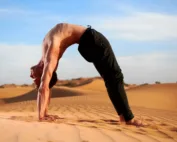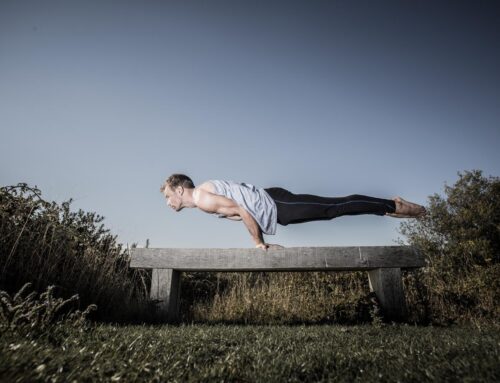
Master the Art of Strength and Serenity with the Yoga Warrior Pose
Welcome to the world of the Yoga Warrior Poses, where each warrior pose teaches the practitioner new insights into their yoga practice. Today, we’re diving deep into one of the most iconic and empowering sets of poses in the yoga postural practice: the Yoga Warrior Poses, or Virabhadrasana. These poses are not just physical exercises; they are a testament to the resilience of the human spirit, embodying the warrior within each of us.
What is the Yoga Warrior Poses (Virabhadrasana)?
The Yoga Warrior Pose, or Virabhadrasana, is named after a fierce warrior, Virabhadra, an incarnation of Lord Shiva in Hindu mythology. This series of poses celebrates the spirit of resilience, strength, and courage. It’s a powerful stance that builds focus, power, and stability.
Warrior Pose (Virabhadrasana)
Sanskrit: Virabhadrasana
Pronunciation: veer-ah-bah-DRAHS-uh-nuh
Meaning of Virabhadrasana: “Vera” means hero. “Bhadra“ means Lord Shiva’s incarnation
English: Warrior Pose
Preparatory Poses to Help Prepare the Body for the Yoga Warrior Pose
Before you embark on your warrior journey, warming up with these preparatory poses will help your body get ready:.
- Mountain Pose (Tadasana): Establishes foundational balance and alignment.
- Downward-Facing Dog (Adho Mukha Svanasana): Stretches and strengthens the whole body, preparing it for the demands of the Warrior Poses.
- Triangle Pose (Trikonasana): Opens the hips and shoulders, useful areas of the body to open for the Warrior pose series.
What are the different Yoga Warrior Pose?
The Yoga Warrior Poses are all about making you feel strong and steady, just like a warrior. The Warrior Pose series comprises of three main variations: Warrior I (Virabhadrasana I), Warrior II (Virabhadrasana II), and Warrior III (Virabhadrasana III).
Each variation engages the body in different ways, promoting strength, flexibility, and balance. Whether you’re new to yoga or have been practicing for a while, the Warrior Poses are a great way to challenge yourself, develop a sense of feeling grounded and build strength and endurance through the body.
Let’s dive in and discover the different Warrior Poses and how they can add strength and confidence to your yoga practice.
Warrior Pose 1 (Virabhadrasana I)
This pose is a powerful stance that creates a great stretch for the hip flexors of the rear hip and leg. Warrior 1 helps to ground the individual by starting with the feet. By starting here at the foundation of the posture, this offers the practitioner an opportunity to ground with the earth. This, in turn, can help support mental clarity and calmness for the practitioner.

Warrior Pose 1 (Virabhadrasana I)
Steps and Tips:
- Begin in Mountain Pose, Widen your feet to hip-width distance, and step back with your right leg.
- Keep the width of your feet to hip-width distance and turn the rear foot (right) toes at about a 30-degree angle.
- Turn your pelvis towards the front foot. Find an alignment of your pelvis that feels spacious in your hips and is not forced.
- Bend into your front knee until you feel activation in your thigh muscles.
- Spread the toes on both the front and back feet.
Benefits of Warrior 1:
It builds power, and stability; strengthens the legs and arms; and brings a sense of calmness to the fluctuations of the mind.
Warrior Pose 2 (Virabhadrasana II)
This pose emphasizes stamina and concentration, with a soothing stretch through the hips. Warrior 2 is a powerful posture that demands strength and endurance through the legs.

Yoga Warrior Pose 2
Steps and Tips:
- Start from Tadasana (Mountain Pose) with feet hip-width apart.
- Step your right leg back. Turn the heel in and the right toes away from your body. Align the outer edge of the rear foot parallel to the back edge of the mat.
- Bend into the front knee. Heel-toe the front foot either in or out, seeking to find a place for the foot that feels spacious in your hips.
- Spread the toes on the front foot. Push down through the mound of the big toe and the outer edge of the heel. Notice how this action creates energy from your foot and can be felt traveling up your leg into your front hip. Spread the toes in the rear foot, pressing down through the mound of the big toe and outer edge of the foot until you can feel the inner (medial) arch of your foot ‘wake up’ and your rear glute muscles contract.
- Extend your arms out to the sides, parallel to the ground, palms down, gazing over your front (left) hand.
- Breathe calmly, keeping awareness at the feet and up through the body.
- Option to lengthen the stance for a more challenging variation.
Benefits of Warrior 2:
Increases stamina/endurance, strengthens legs, arms, and back; enhances concentration; opens the chest and shoulders.
Warrior Pose 3 (Virabhadrasana III)
This pose is a test of balance, concentration, and strength all in one package. The integration of the body into a dynamic line from the fingertips to the rear foot. This posture differs from that of Warrior 1 & 2 as the practitioner is required to balance on one leg. This, of course, comes with its benefits as well as an increased level of difficulty.

Warrior Pose 3 (Virabhadrasana III)
Steps and Tips:
Benefits of Warrior 3:
Strengthens and tones the ankles and legs; improves balance and posture; and enhances concentration.
Modifications and Variations for Yoga Warrior Pose
Benefits of Practicing Yoga Warrior Pose
Practicing the yoga warrior poses is not just about physical strength; it’s a holistic approach to developing mental and emotional resilience. These poses teach us to stand our ground, face challenges head-on, and cultivate inner strength and peace. Here are some other benefits:
Common Mistakes to Avoid while Practising Yoga Warrior Pose
Avoid Practicing Virabhadrasana If You Suffer From
Practice Tips for Beginners
Final Thought
Whether you’re taking your first steps into the world of yoga or you’re an experienced practitioner seeking to deepen your skills, our online classes provide tailored instruction for mastering yoga warrior poses. Connect with Dav Jones Yoga on the Patreon channel or have a look at the DJY Mentorship programs. Learn how we can support your journey toward achieving strength, balance, and focus through this powerful stance.










[…] Warrior I (Virabhadrasana I): […]